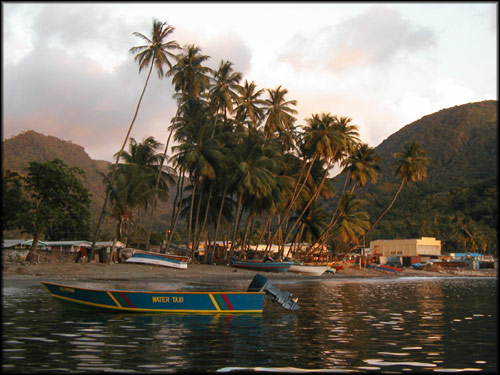Click
Back to the
"Latest News"
for additional
Log Entires
|
The Hazards of
Living Under A Volcano

March 15th,
We left Petite Byahaut, St.
Vincent headed toward St. Lucia on February 3rd. We had a lovely sail
between the islands and arrived in Soufriere, St Lucia an hour or so before
sunset. All of the moorings in the marine sanctuary were full and due
to the depth of the bay the only other option was anchoring just off the
beach and tying a line to a palm tree on shore. We had more than our fair
share of assistance as two rival boat boys vied to be our selected helper.
All the effort of both the boys was fruitless for we had none of what
they were after: cash. But the winner of the the job helped us anchor
and once we were securely in place, graciously accepted the only payment
we could offer, a cold glass of apple juice.
Anchoring just off shore meant
we had a calm night with little rocking from swells or waves. We settled
down in bed happily anticipating a calm restful night when a sound caught
our ears and we looked at each other in horror. The mosquitos were out!
Being so close to shore made it easy for them to sniff us out, or do whatever
they do to find warm blood, and we knew it would be a night of hiding
in the sheets and slapping ourselves in the ear. The next morning we awoke
from our restless slumber, happy to move northward away from Soufriere
and the mozzies.
A short hop up the coast of
St. Lucia brought us to Rodney Bay, the northern most bay on the island.
We anchored here ate lunch and then snorkeled ashore to explore. At the
top of a large hill stood an old British fort that had been erected in
the 19th century but was used up until World War II as a listening station
by the American Army. We climbed up to the top to behold a fantastic blue
vista out across the Atlantic and Caribbean Seas, below a tempestuous
cauldron of blue water turning frothy white against the rocky cliffs,
and on the horizon 20 miles away a smudge of land called Martinique: our
next stop.
St. Pierre, Martinique was
at one time the cultural and social center of the French West Indies.
Known as the Paris of the Caribbean it boasted a population of 30,000
and was considered a center for fashion and art. A theater along the Rue
De Victor Hugo provided a grand gathering place and hosted touring productions
from Paris and other major cities. But, the European Settlers who had
successfully wiped out the Carib residents in order to reside here had
overlooked one major potential problem. St. Pierre was situated at the
foot of the Mt. Pelee volcano.
In 1902 the governor of St.
Pierre was up for reelection but there were problems on the campaign trail.
Mt. Pelee had started acting up. Rumblings and small eruptions had started
scaring St. Pierre's residents into leaving. In order to win the Mayor
needed to convince St. Pierre's citizens to stay in town. So he hired
a scientist to say there was no danger. He managed to stop people from
leaving town, but wasn't so successful at stopping the volcano which erupted
wiping out the whole town, including the Governor, in a cloud of super
heated gas. There was one survivor, an inmate in the local prison, who
escaped the catastrophic explosion with only burns to his skin because
he had been locked in a thick stone cell. He later went on to tour with
Barnum's Circus as the sole survivor of the destroyed city of St. Pierre.
Today St. Pierre still lives
in the shadow of the active volcano, but life goes on as normal. New buildings
sprang out of the ruins and the town is an interesting mix of old and
new. Most of the new houses and stores are built onto old structures and
have at least one wall that is from the old city. Ruins of the theater,
the prison, and numerous stores and houses are scattered around town.
And a small museum documents the explosion and contains many interesting
artifacts found in the rubble of the destroyed town. Miranda and I spent
a couple of nice days here exploring the town, then thought it wise to
leave while our luck was still good and the volcano stayed quiet.
Another day trip with light
easterly winds took us to Dominica and along the way we were visited by
some dolphins who played in our bow wave for ten minutes or more. Miranda
and I jumped on the bow to watch them dart back and forth in front of
us. We wondered what they were saying about us as we listened to them
chatter. We squeaked back to them and smiled as they splashed and jumped
around the boat. Then they left as quickly as they appeared and we sailed
into our anchorage with a renewed sense of joy.
|

